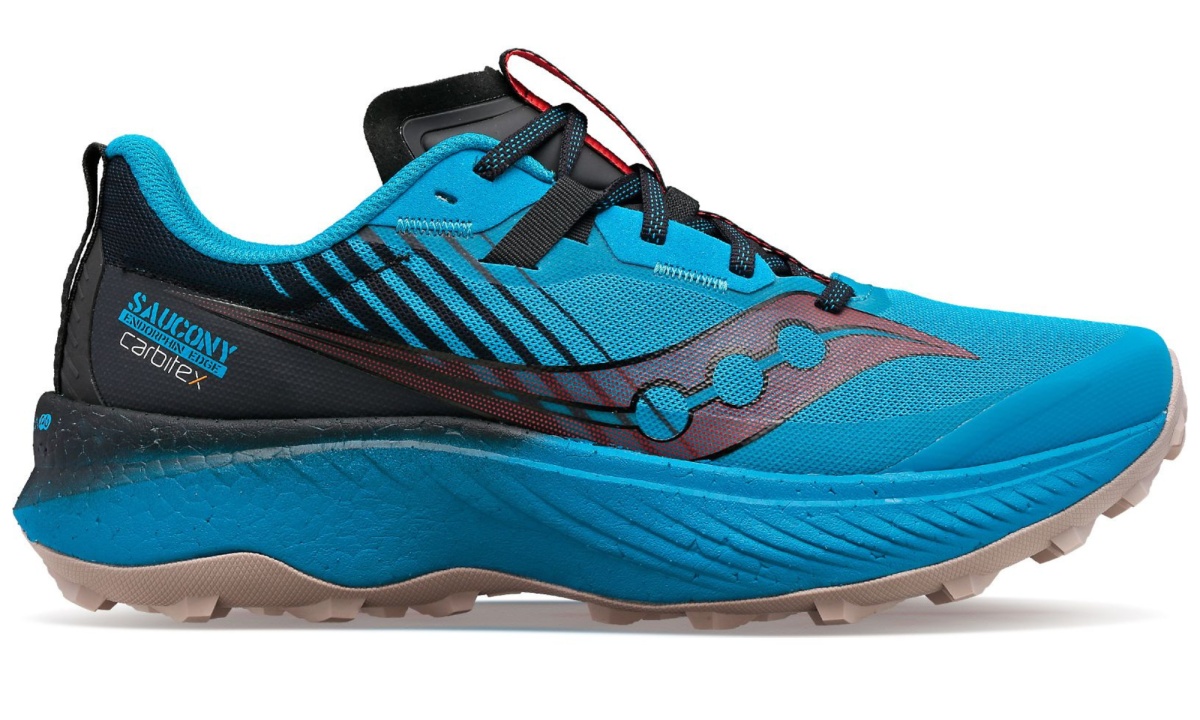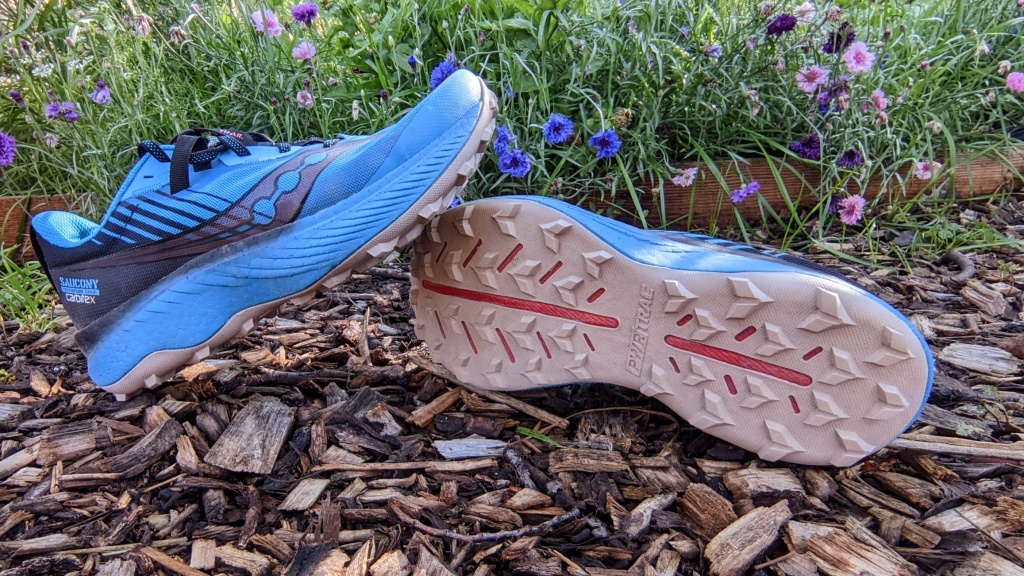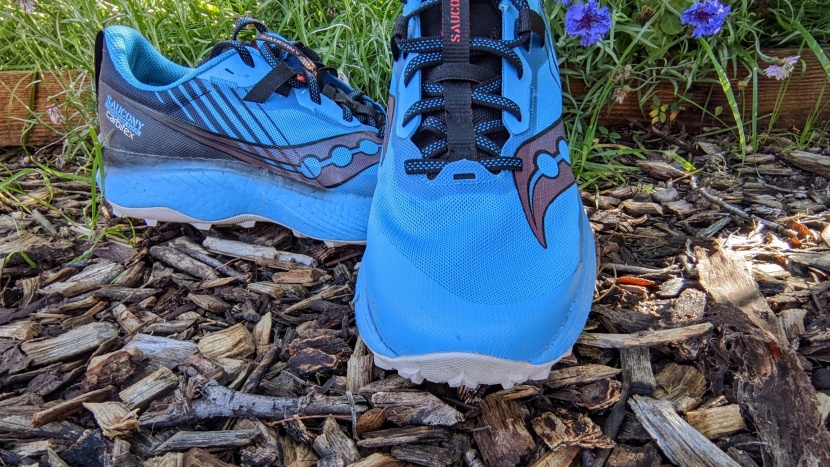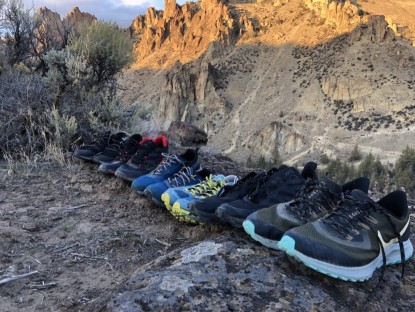Saucony Endorphin Edge Review
Our Verdict
Our Analysis and Test Results
The Saucony Endorphin Edge nicely compliments the ever-popular Peregrine series as another ultra-lightweight trail runner. But the Endorpin series takes their speedy shoes to the next level by layering a Carbitex MonoFlex carbon fiber plate onto the already energetic foam of their proprietary PWRRUNPB, dual-layer midsole. Thanks to an ultralight mesh upper, Saucony designers packed all of this technology into a shoe that weighs a mere 9.73 ounces per shoe (men's 10.5 US). Unfortunately, ultra-powerful and ultra-lightweight don't always pair well together; this shoe needs more structure from the upper to truly unlock the potential of the carbon fiber midsole.
Foot Protection
Carbon fiber is a rigid compound. Most carbon plates are stiff in all directions, which can present serious problems for runners who need a shoe to match the natural flexibility of their feet. A Monoflex plate is different. This carbon fiber insert is stiff torsionally (side-to-side), providing extra support and stability. But it is asymmetrically flexible in the fore-aft direction, allowing the shoe to flex with each stride. When you flex the Endorphin Edge in your hands, the potential energy stored in this carbon fiber plate explodes kinetically as the shoe snaps back into form. Running, it feels powerful — not necessarily stiff — and offers a very solid platform for such an ultralight shoe.
An additional nylon rock guard offers additional support and mostly guarantees protection from any terrain underfoot. As we've alluded to, none of the issues with the Endorphin Edge stem from problems with the midsole construction but rather from the upper. The majority mesh upper offers minimal protection from bumps and lumps when the going gets tough. The prescriptive rocker of Saucony's proprietary SPEEDROLL geometry feels like it directs your foot to pronate to promote drive and propulsion off your big toe. This wouldn't be an issue, except that the toe box and bumper are so thin that our testers often smashed their toes in technical terrain.
Traction
The Endorphin Edge is much more of a hardpack cruiser than a technical trail mover and shaker. The drop is average among our lineup (we measured it at 8mm), but the 35mm heel stack height is substantial. Although this shoe's geometry is designed for powering through long runs across simple terrain, the carbon fiber platform makes this shoe a climbing machine by providing a solid platform for consistent strides uphill. The sagittate, 3.5mm lugs of Saucony's proprietary PWRTRAC outsole do a great job of pulling through mud without clogging, and the wide lug pattern handles rocks really well. Once again, it's not the outsole's traction that is the issue, but rather the way the overall design works (or doesn't) together. The traction may be great, but the Endorphine Edge is flat-out unstable in uneven terrain.
Sensitivity
Unlike other lightweight shoes we've tested, you shouldn't expect much trail feel out of the Endorphin Edge. Not only is the stack height at the top end of the spectrum — tapering from 35mm in the heel to 27mm in the toe box (Saucony claims 29mm in the forefoot, but we measured a bit lower) –--but the carbon fiber midsole construction is designed to absorb and deflect any resistance underfoot. You could think of it as a carbon fiber Formula One car absorbing friction through a corner to deliver maximum power output. Looking closely at the construction, most of this shoe is comprised of the midsole; the outsole is relatively thin in comparison.
Stability
An equitably wide platform offsets the stack height of the Endorphin Edge. The outsole tapers away from a surprisingly wide toe box, and the rest of the shoe has an ample last through the midfoot and heel. Unfortunately, this does little to improve stability. Simply put, this is one of the most unstable shoes we have ever run in. The issue seems to be that the highly energetic midsole overpowers the ultra-thin, ultra-lightweight upper. Even locking down the laces so tightly that we were cutting off circulation across our instep, we couldn't keep our feet from bouncing and sliding around inside the upper frame.
The unfortunate result is a trail runner that is incapable of sidehilling, is downright scary to run in technical terrain, and isn't very stable on anything but rolling double track. Hopefully, designers can overcome these issues by redesigning an upper that offers more structure, which seems like it would offer more support for the powerful midsole and ultimately improve the stability of this promising platform.
Comfort and Fit
The midsole construction of this shoe is well-designed. It is prescriptive without being overly so, offering a level of support and comfort akin to a stiff memory foam bed. However, the shape of the Endorphin Edge is odd. The design is hourglass shaped: a relatively normal width in the heel pocket tapers through a very narrow last in the midfoot, opening up into an overly wide toebox. Even though it includes a sock liner, the platform is too wide, and the upper otherwise doesn't offer enough structure to keep your foot from sliding around inside. Not to sound like a broken record here, but our biggest complaint is that the upper needs more structure to support the rest of the shoe.
Weight
Tipping the scales at only 9.73 ounces per shoe for a men's 10.5 US, it is insane how much technology Saucony designers have packed into this ultra-powerful platform. However, the Endorphin Edge runs superlight on flats but is so squirrely in technical terrain that you feel like you cannot let loose for fear of it propelling you into an ankle sprain. What's the point of an ultralight shoe if you can't use it to run fast?
Should You Buy the Saucony Endorphin Edge?
There will always be trail runners like ourselves who find new shoe technology irresistible. In their first attempt, Saucony has tried to make a shoe that is the best of both worlds: super powerful while remaining ultralight. The result is that these two characteristics seem to cancel each other out, at least when it comes to technical trail running. We have high hopes for this super shoe and are excited to see how this platform develops. But comparing performance to price point, we would only recommend the Endorphin Edge for those running or racing long mileage over simple terrain, like forest roads.
What Other Trail Running Shoes Should You Consider?
The Saucony Endorphin Edge is directly comparable to the Saucony Peregrine 13, except that the latter has been finely tuned over twelve iterations. If the allure of carbon fiber is too much to ignore, the Hoka Tecton X 2 incorporates similar technology. Although it is not nearly as grippy as the Endorphin Edge, it is much more stable in variable terrain. For a similar level of foot protection in a shoe with a much more stable platform, our highest recommendation is the award-winning Salomon S/Lab Ultra 3.













